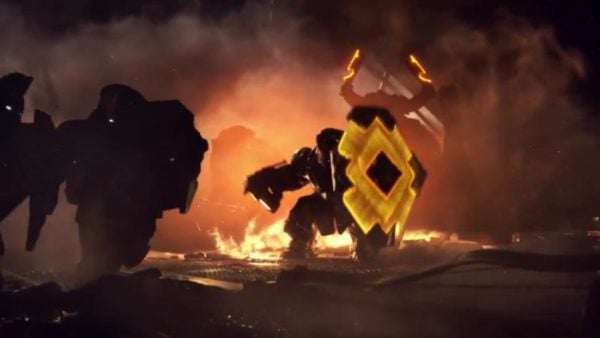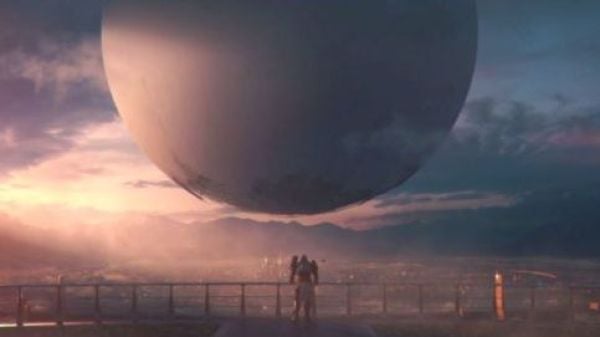Walking into the Destiny 2 gameplay reveal sent a lot of mixed feelings running through my head. The first game received a lot of criticism when it released back in 2014, and a substantial portion of those were 100% valid. Yet here I am three years later with well over 500 hours logged into Bungie’s shared world shooter, looking forward to what comes next. Over time, the house that built Halo’s newest IP started to transform, and become something a lot closer to what was initially promised. All while maintaining gameplay that provided some of the best FPS action I’ve experienced on console to date. While Destiny did improve over time, with the developers taking every complaint and query from their thriving community into account, it was time for something new. Destiny is ready for a new phase, one which couldn’t simply be patched in, and that’s something that the mysterious Destiny 2 was set to offer, and Bungie was finally ready to show that last week.
When the first feed of gameplay finally hit the big screen, I was shocked with how familiar it all looked. I wasn’t sure what I was expecting, but The UI, the Tower, even many of the abilities I saw popping off around me were all things I remembered from vanilla Destiny. But as the video progressed, there were subtle differences that showed how the game I had spent hundreds of hours on was going to evolve. A new ability here, a new weapon type there, and, most importantly, a two-sided struggle that players were going to truly feel a part of. Zavala threw up a bubble to protect you, Cayde-6 let off rounds from his hand cannon, Ikora showed off the mighty mysticism of the Warlock class, and none of this was in some cutscene, it was happening right in front of you during a mission as you fought valiantly to stem the tide of a Cabal onslaught.
Even while watching on screen, as exciting as the touches may have been to see played out in front of me, it wasn’t until I actually got my hands on Destiny 2 that it really started to click. During the event I got to try a few hands-on demos on both the PS4 Pro and PC that provided a taste of the myriad changes made to the popular shooter and a hint of what’s to come.
Looking at PS4 first, the visuals were the first indicator that this is something new. The first Destiny is no slouch in the graphics department, with some solid effects and beautiful worlds to explore. But it’s no secret that the engine was somewhat held back by the previous generation of consoles. With that weight lifted off, there’s a lot more detail in everything around you. From the cloth of a Warlock’s robes, to the sheen of a Hunter’s blade, the increase in visible detail helps to pull players into the experience. That detail extends to the world around the Guardian. More detail pops from the buildings and surfaces, explosions fill the screen, enemies move naturally through the environment as they make their way over to snuff out your light.
Gameplay in Destiny 2 is even crisper than before, which is saying something. Destiny 2 feels less floaty than its predecessor. Movement and aiming feel much more precise, with abilities and gunfire adding a satisfying punch to the action. Returning players will feel right at home as you leverage your hovering, melee attacks, various grenades, and powerful firearms to push back any threats. That same flow of combat, easily Destiny’s strongest factor, is still present and accounted for, but it’s expanded in a simple but meaningful way. In addition to having abilities like grenades and melee attacks, each of the classes now has a new class ability which helps to bolster their unique niche on the battlefield and further define their role.
Fans of the Nightstalker subclass will be happy to learn that the Shade Step is now a Hunter wide ability that’s available on a relatively short cooldown, allowing it to be used with things like the updated Gunslinger. Titans now feel a lot more tanky thanks to higher damage resistance and a class ability that allows them to summon a wall of light capable of stopping any incoming damage. And Warlocks finally become bona fide healers or support classes thanks to their new class ability which drops a small pool of light that can be set to either heal or buff attack damage. They’re small, simple inclusions, yet in practice they proved to change how gameplay was approached with each individual class. These abilities added a new, strategic layer that should lend themselves to more involved teamwork than ever before. This is something that became apparent during Destiny 2’s new PvP mode – Countdown.
Countdown is very much a mix between Destiny and Counter Strike. It’s 4v4 (as all multiplayer modes will be going forward in the sequel), and tasks teams with swapping between defense and attack as bombs are planted and need to be diffused. Thanks to the elimination rules of the fight, you can’t play recklessly or else you’ll quickly cost your team the game. This is when the different roles came into play. I jumped in as the updated Striker Titan and was joined by two Dawnblades and a Gunslinger. The new wall of light class ability allowed me to create choke points for our team’s Gunslinger to have a more “fish in a barrel” advantage over the enemies. To balance things out and put on the pressure, the enemy team utilized its Warlocks to rain hell from above, forcing us to find new shelter away from the trap we set. There was a constant back and forth of that, with one team using its classes in one way and the other figuring out ways to turn the abilities on their head to find a new advantage. Adding to the tension was the UI which kept useful information visible at all times, with the most important part being a clear indicator of everyone’s super charge.
You can see who on the other team has a super ready, which allows for your team to plan around it. Having your super puts you in a special position as well, as now you know you have a target on your back which you can leverage to set traps, or steer the opponent away from certain areas. The way supers now work helps this all out as well. Some of these ultimate abilities work completely differently this time around, changing how you play for a few seconds rather than just being a quick attack. Take the Striker for instance, who becomes an electrified juggernaut for a few seconds, capable of demolishing entire areas. It’s a welcome change that builds on the approach The Taken King had when it added new subclasses that had more strategic depth.
What surprised me most about all these changes is how they all play on PC. Destiny 2 on PC feels like an entirely different game. For starters, the game starts at a base of 60fps but can be completely unlocked making for some of the smoothest, sharpest gameplay I’ve yet to enjoy with a Guardian. It’s a distinct visual advantage over console’s locked 30 FPS. The visuals also have an extra pop that lend themselves quite well to the large battles. To be completely honest, I had expected little more than a port, which have been fine considering the PC version didn’t even exist for the original Destiny, yet it was clear that Bungie wasn’t planning on taking the easy way out. Destiny 2 played extraordinarily well on the rigs that were set up, and I, a person who would fare better with an Atari joystick than a mouse and keyboard any day, was able to jump in and completely lose myself to the spectacle of the new Inverted Spire Strike. While they may have missed out on the first game, PC players are in for a treat.
Yet for all these improvements, and the amount of fun I had while playing Destiny 2, it became clear to me that it was because I was already a big fan of the game. As I mentioned before, I have hundreds of hours spent exploring the galaxy, clearing strikes, and triumphing over raids on all difficulties on the first Destiny. Destiny 2 felt familiar, and its various upgrades combined to create a welcome improvement over the first game, but this was still very much like that first game. The changes are clearly there to give returning players more of what they enjoy, and new players an opportunity to experience what makes Destiny so great. What it isn’t clearly doing as well, is giving a reason for people who didn’t like the original to come back into the fold. An improved story may not be enough for some of if the game feels more or less the same but smoother.
Bungie made it quite clear that they were building this game for the community, and that shows in every aspect of what I got to experience. All of the little qualms that myself and many others shared were touched upon, and I’m sure there are many more improvements and updates to come, and that has me excited to jump back into this universe. However, Destiny 2 is still very much Destiny for better or for worse. If you love that, then Sept. 8 will be like an early Christmas for you and your friends, and if you’ve yet to try Bungie’s latest IP, this will certainly be a great place to start.
Of course, there is still a lot that hasn’t been experienced yet that can transform the experience even more. We didn’t get to explore the new, open worlds spoken about in the keynote, nor was the loot system in place to fiddle with. Those are two areas that can completely turn Destiny 2 on its head. But for now, with what I actually got to spend time playing, Destiny 2 has reminded me of how I got sucked in the first time, and I’m not even a tiny bit upset about that.


